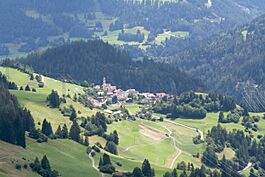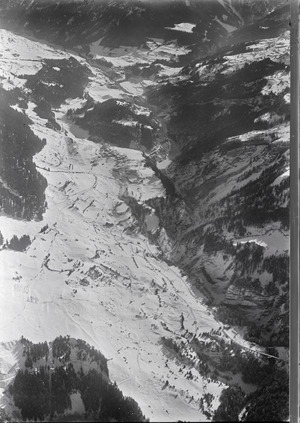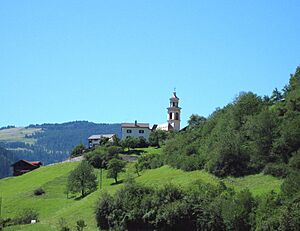Alvaschein facts for kids
Quick facts for kids
Alvaschein
|
||
|---|---|---|
 |
||
|
||
| Country | Switzerland | |
| Canton | Graubünden | |
| District | Albula | |
| Area | ||
| • Total | 4.06 km2 (1.57 sq mi) | |
| Elevation | 1,001 m (3,284 ft) | |
| Population
(Dec 2013)
|
||
| • Total | 142 | |
| • Density | 34.98/km2 (90.6/sq mi) | |
| Postal code |
7451
|
|
| Surrounded by | Brienz/Brinzauls, Lantsch/Lenz, Stierva, Tiefencastel, Vaz/Obervaz | |
Alvaschein (in Romansh: Alvaschagn) was a small town, also called a municipality, in the canton of Graubünden in Switzerland. It was located in the Albula district.
On January 1, 2015, Alvaschein joined with several other towns. These towns were Mon, Stierva, Tiefencastel, Alvaneu, Brienz/Brinzauls, and Surava. Together, they formed a new, larger municipality called Albula/Alvra.
Contents
Coat of Arms
The coat of arms for Alvaschein has two main parts. One part is black with a broken silver key. The other part is silver (or white) with a black carpenter's axe.
These symbols are important because they represent the patron saints of the local churches. The key stands for Saint Peter, who is honored at the church in Mistail. The axe represents Saint Joseph, who is the patron saint of the church in Alvaschein.
Geography
Before it merged, Alvaschein covered an area of about 4.1 square kilometers (about 1.6 square miles). A large part of this land, about 58%, is covered by forests. About 31% of the land is used for farming.
The rest of the land is used for buildings and roads (about 7.4%). A small part (3.2%) is made up of natural features like rivers or mountains.
Alvaschein is located in the Albula District. It sits on a flat area, like a terrace, which is north-east of the Albula river. It is also near the Stausee Solis reservoir. The town is along the routes to the famous Julier and Albula Passes.
Neighboring Towns
Alvaschein shared borders with several other towns. These included Brienz/Brinzauls, Lantsch/Lenz, Stierva, Tiefencastel, and Vaz/Obervaz.
Population
Population Changes Over Time
The number of people living in Alvaschein changed quite a bit over the years. In the late 1800s, the population stayed around 137 to 156 people.
The highest population was in 1900, when 276 people lived there. Many of these people were workers building the Albula train line. The population was also higher than usual in 1970 for similar construction reasons.
After 1900, the population went down, then rose slightly until 1950. It then fell in the 1980s. Since then, the number of people has stayed around 150. In 2013, Alvaschein had 142 residents.
Languages Spoken
Long ago, the main language spoken in Alvaschein was Romansh. Today, fewer people speak it.
Most people in Alvaschein now speak German. In 2000, about 53% of the population spoke German. About 40% spoke Romansh, and about 3% spoke Italian.
| Language | 1980 | 1990 | 2000 | |||
|---|---|---|---|---|---|---|
| Number | Percent | Number | Percent | Number | Percent | |
| German | 73 | 48.99% | 64 | 44.13% | 82 | 53.25% |
| Romansh | 71 | 47.65% | 67 | 46.21% | 62 | 40.26% |
| Italian | 5 | 3.36% | 2 | 1.38% | 5 | 3.25% |
| Total Population | 149 | 100% | 145 | 100% | 154 | 100% |
Religion
During the time of the Reformation, the people of Alvaschein chose to remain Roman Catholic.
As of 2000, most residents (about 73%) were Roman Catholic. About 15% were Protestant, and nearly 2% were Orthodox Christians. A small number of people were Muslim (2.6%) or atheist (1.95%).
Origin and Nationality
At the end of 2004, most of the 149 people living in Alvaschein were Swiss citizens (about 96.6%). In the last census, about 92.8% were Swiss citizens, and some of them had dual citizenship (meaning they were citizens of two countries).
The few people who had moved there from other countries came from places like Germany and Serbia and Montenegro.
Education
In Alvaschein, many adults have completed higher levels of education. About 56% of people aged 25 to 64 have finished either non-mandatory high school education or even higher education. This could be from a university or a specialized college (called a Fachhochschule in Switzerland).
Economy
In 2000/2001, there were 17 workplaces in Alvaschein where 50 people earned their living.
- In farming and forestry, there were 7 workplaces with 17 employees.
- In industry and trade, there were 3 workplaces with 20 employees.
- In services (like shops or offices), there were 7 workplaces with 13 employees.
Alvaschein had a very low unemployment rate of 0.35%. In 2005, 14 people worked in the primary economic sector (like farming), and there were about 6 businesses in this area. Another 14 people worked in the secondary sector (like manufacturing), with 2 businesses. Finally, 21 people worked in the tertiary sector (like services), with 8 businesses.
History
Alvaschein was first mentioned in historical records in 1154. This was when a nunnery (a place where nuns live) called Alvasinis was built.
In 1282, the town came under the control of the Princes-Bishop of Chur. Later, in 1367, it became part of the municipality of Gotteshausband. The people of Alvaschein finally bought their freedom from the Princes-Bishop in 1732.
Sadly, almost the entire community was destroyed by a big fire in 1745. Since 1851, Alvaschein has been the main town of its own district.
Attractions
One of the most important places to see in Alvaschein is the Carolingian-era church of St. Peter Mistail. This church is very old and important. It is considered a monument of great cultural and historical value to Europe. It is also listed as a Swiss heritage site of national significance.
The main village church is named St. Joseph. It was built between the years 1653 and 1657.
See also
 In Spanish: Alvaschein para niños
In Spanish: Alvaschein para niños






